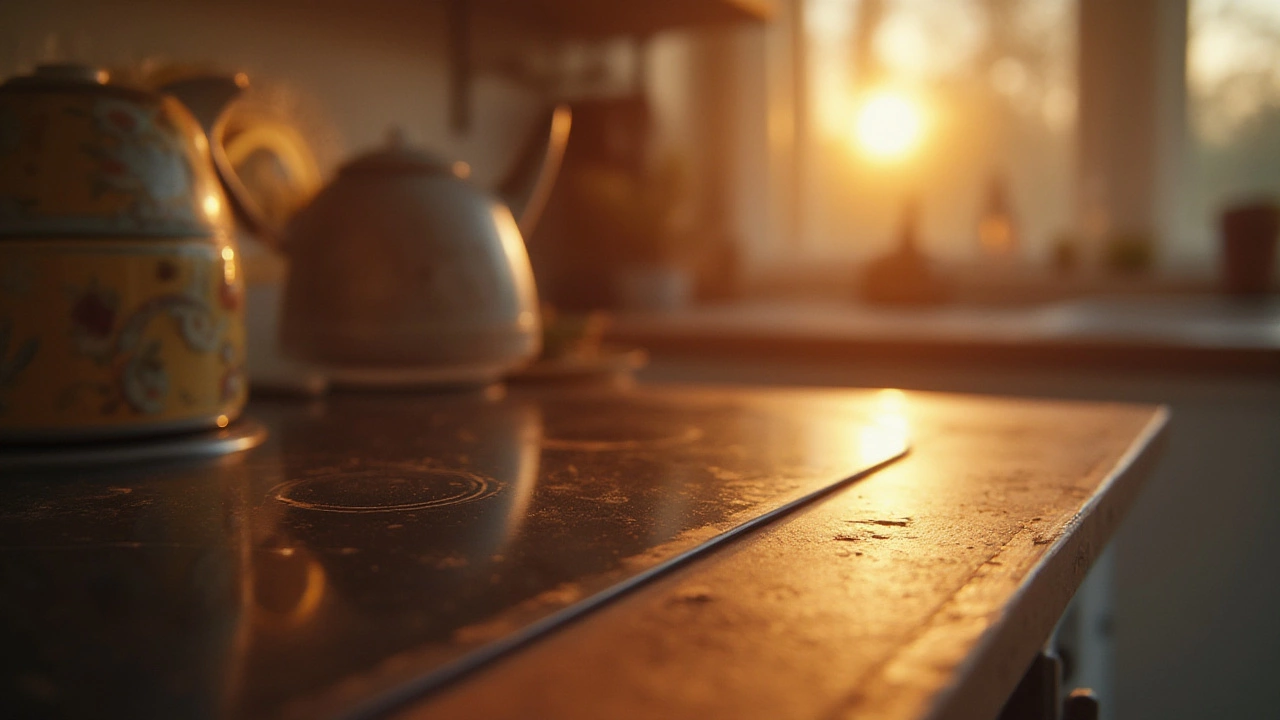
- 20 Jul 2025
- Gideon Thornton
- 0
Picture this: You’re halfway through making a family meal, and suddenly your electric hob quits on you. Annoying? Definitely. But before that happens, wouldn’t you like to know what to expect from your trusty hob, and maybe squeeze a few extra years out of it? Electric hobs are the backbone of many kitchens, taking daily use and the odd spill in stride. Yet, most people have no clue how long these appliances really last—or how to tell when one's reaching the end of its working life. Let's just say, there’s more to lifespan than a number in a manual. Real kitchens, real habits, and even that one corner burner everyone ignores can mean your hob’s longevity is truly unique.
What’s the Typical Lifespan of an Electric Hob?
People often guess that all kitchen appliances should soldier on for a decade, but the honest answer is: it depends. For electric hobs, the average lifespan comes in at around 10 to 15 years. Some models surprise their owners by lasting even longer, while others might falter before crossing ten. A big factor is the quality of the hob right out of the box. Entry-level models from lesser-known brands might show signs of aging earlier, while reputable brands with solid reputations—think Bosch, Neff, or AEG—usually clock in at the upper end or beyond.
Hob lifespan isn’t just about the calendar. How often you cook makes a huge difference. If you whip up three meals a day, every day, you’re likely to see a little more wear than someone who heats up soup every now and then. Even the climate in your home plays a role; kitchens with high moisture or lots of dust might chip away at a hob’s components. There’s also the element of luck—factory defects, power surges, or a particularly stubborn spill can sometimes cut things short.
The type of electric hob matters too. Solid plate models tend to be simple and tough—they can keep ticking for years if you treat them right, though they may build up stains or lose efficiency over time. Ceramic and induction hobs, being newer technologies, are usually designed with more sensitive touch controls and more complex electronics. That means more features to enjoy, but also more things that could theoretically go wrong after a decade or so. Manufacturers recommend replacing old ceramic or induction hobs around the 15-year mark, but with good care, you might squeeze a few bonus years out of them.
| Hob Type | Average Lifespan (Years) |
|---|---|
| Solid Plate Electric | 10-15 |
| Ceramic Electric | 10-15 |
| Induction | 12-15 |
Still, it isn’t just about ticking years off the calendar. Pay attention to performance: Is your hob taking longer to heat up or not holding its temperature? Are the control dials or sensors less responsive than before? These common warning signs show your hob’s best years might be behind it, even if it hasn’t reached a milestone birthday yet.
Common Issues That Cut a Hob’s Life Short
Here’s a not-so-fun fact: around 30% of electric hob breakdowns reported to major UK repair services are caused by simple day-to-day mishaps, not manufacturing defects. Everyday life is rough on appliances. Dragging heavy pans across glass surfaces can leave scratches that eventually form cracks. Overflowing pots? The moisture and goo can slip into the electronics and cause havoc—especially in modern hobs packed with sensors and touch controls.
One silent killer is power surges. If you’ve ever had the lights flicker or tripped a circuit breaker by accident, your hob probably took a hit too. Even if you can’t see the damage right away, those tiny electrical jolts can slowly wear out internal components, leading to expensive repairs down the line. Investing in a surge protector for your kitchen circuit is almost like giving your hob life insurance.
Hard water is another sneaky enemy. If you live in an area with limescale-laden tap water, spills left to dry on your hob can leave a chalky residue that becomes hard to remove over time. This doesn’t just look bad; it can also gum up sensors or slow down heating. Regular cleaning is your best friend—but use the right cleaners. Abrasive pads and harsh chemicals are a no-go for glass or ceramic surfaces. Gentle, purpose-made cleaners do the trick without dulling the shine or scratching the finish.
Sometimes, the problem is less about wear and more about wiring. Older homes might have outdated electrical systems that can’t always supply the steady flow your hob needs. Unstable or insufficient power is a recipe for blown elements and burned-out circuits. If your hob repeatedly trips the breaker, it might be time to check the wiring instead of blaming the hob itself.
Certain brands have their quirks, too. Reviews from appliance repair forums show that older models from some low-cost brands struggle with touchpad failures or heating element burnout within 8 years. More established brands tend to be more reliable, but nobody's immune—fluke breakdowns can and do happen. If you’re unlucky enough to have a Monday morning machine, you might see the repair technician sooner than you’d like.

How to Make Your Electric Hob Last Longer
Even though every appliance has a shelf life, there’s plenty you can do to help your electric hob lifespan match, or even exceed, the averages. It all comes down to proper use—plus a little TLC. The golden rule: keep it clean but gentle. After each meal, let the hob cool and then wipe it down using a soft cloth. Forget wire scouring pads or anything meant for stubborn pans; they’ll scratch or dull the surface, inviting even bigger problems later.
For ceramic or induction hobs, stick with non-abrasive cleaning products. There are special creams and sprays designed just for glass or ceramic surfaces. Used right, they’ll make stubborn food residue disappear and keep the hob looking brand new. If something spills, try to wipe it up quickly before it has the chance to bake on and cause stains or pitting.
Pay attention to the size and condition of your pots and pans. Flat-bottomed cookware ensures even heat distribution and minimizes stress on the heating elements. Warped pans can create hot spots that lead to overheating (and sometimes cracking) of the glass. Give extra-hefty cast iron cookware a miss if you want your hob to last, especially on glass surfaces—it’s heavy, unyielding, and much more likely to cause cracks if dropped.
If you have an induction hob, keep the surface free from ferromagnetic debris—like loose screws or tiny metal fragments. These bits can heat up much faster than a pan, leaving scorched marks or causing the safety sensors to trip.
Avoid dragging cookware across the hob, and always lift pans off instead of sliding them. This simple habit will help you avoid scratches or micro-cracks, which could turn into big trouble after a while. It might feel like an extra step, but over a decade of use, it makes a big difference.
Another secret to longevity is giving your hob time to cool down. Repeatedly blasting high heat can lead to premature aging of heating elements and sensitive sensors. Try alternating between high and medium settings, and avoid covering the vent holes.
Last, but never least: don’t ignore small issues. Cold spots, flickering indicator lights, or inconsistent heat are early warnings. Getting these fixed early often means swapping a single affordable part, instead of waiting until the whole hob is fried and you’re stuck buying a brand-new appliance.
- Wipe up spills immediately and use a microfiber cloth
- Stick to cookware with flat, smooth bottoms
- Clean regularly with hob-specific cleaners
- Avoid placing hot pans on cold surfaces
- Keep vents clear and don’t block control panels
- Have electrical wiring checked if you notice frequent circuit trips
- Address burnt-out indicators or slow burners sooner, not later
- Use a surge protector if possible
When is It Time to Replace Your Electric Hob?
Let’s be honest, sometimes you just know the party’s over. Even with the best care, electric hobs don’t last forever. But how do you know when fixing isn’t worth it anymore? The biggest clue is cost—if repairing your hob is more than half the price of a new one, replacement almost always makes more sense. New models often bring energy savings and better safety features anyway.
Frequent breakdowns, unpredictable heating, and completely dead zones on the hob are strong signs the internal elements are on their last legs. If touch controls stop responding or you see error codes popping up more and more often, the electronics may be too frazzled to trust for everyday use. By this stage, you’re probably living with minor frustrations, like waiting ages for pots to boil or dealing with half-cooked meals. That’s your cue.
Energy usage is another giveaway. Older electrical components usually draw more power to deliver the same heat. If you notice your kitchen bills climbing without any change in cooking habits, your hob could be working overtime—again, a hint that it’s no longer running efficiently.
If you’re remodeling your kitchen or updating appliances for better energy efficiency, this is the perfect moment to let that old hob bow out gracefully. Newer hobs often come with smart controls, safety locks, rapid heat-up features, and cleaner lines, all of which can bring new convenience and even longer lifespans.
One last tip: Keep your warranty papers handy. Even if your hob is several years old, some brands offer extended warranties on certain parts. Before tossing the old hob, check if you’re entitled to a discounted repair or replacement. And if you’re still on the fence, ask a professional. Most appliance repair engineers can diagnose the real remaining lifespan of your hob with one service call, based on wiring, wear, and performance data.
So next time the question pops up—how long do electric hobs last?—remember, it’s part science, part luck, and a lot of daily habits. Treat your hob right, and it’ll return the favor, meal after meal.

